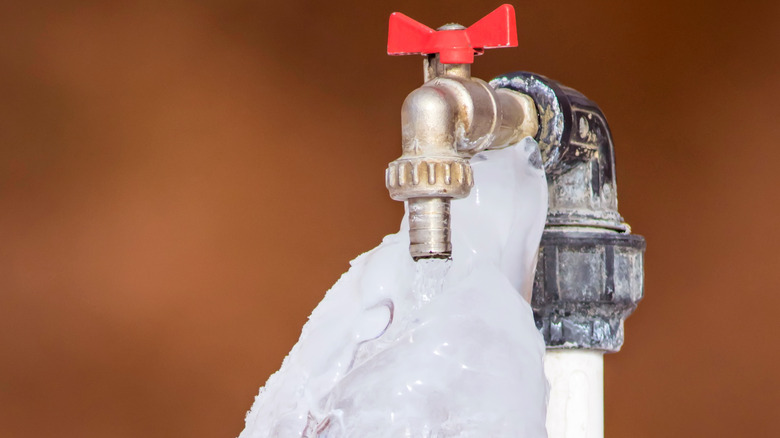We've unearthed this post involving Helpful Tips to Prevent Frozen Pipes this Winter below on the internet and concluded it made perfect sense to quickly share it with you over here.

Winter can wreak havoc on your plumbing, specifically by freezing pipes. Here's just how to stop it from taking place and what to do if it does.
Introduction
As temperatures drop, the risk of icy pipes increases, possibly causing pricey repair services and water damage. Understanding just how to avoid frozen pipelines is essential for home owners in chilly environments.
Avoidance Tips
Insulating susceptible pipes
Cover pipelines in insulation sleeves or make use of heat tape to safeguard them from freezing temperature levels. Focus on pipes in unheated or exterior areas of the home.
Heating strategies
Keep indoor rooms adequately heated, particularly areas with pipes. Open cabinet doors to enable cozy air to circulate around pipes under sinks.
Exactly how to determine icy pipes
Look for lowered water circulation from faucets, uncommon odors or sounds from pipelines, and visible frost on revealed pipelines.
Long-Term Solutions
Structural adjustments
Consider rerouting pipelines away from outside walls or unheated locations. Add additional insulation to attic rooms, basements, and crawl spaces.
Upgrading insulation
Buy high-grade insulation for pipelines, attic rooms, and wall surfaces. Proper insulation helps keep consistent temperatures and lowers the risk of frozen pipelines.
Shielding Exterior Plumbing
Yard hose pipes and outside taps
Separate and drain pipes yard pipes prior to wintertime. Set up frost-proof faucets or cover outside faucets with shielded caps.
Understanding Frozen Pipelines
What triggers pipes to ice up?
Pipes freeze when exposed to temperatures listed below 32 ° F (0 ° C) for expanded durations. As water inside the pipes freezes, it broadens, putting pressure on the pipeline walls and possibly creating them to burst.
Threats and problems
Frozen pipelines can cause water disruptions, residential property damages, and expensive fixings. Burst pipelines can flooding homes and trigger considerable structural damages.
Indicators of Frozen Pipes
Determining icy pipelines early can stop them from rupturing.
What to Do If Your Pipelines Freeze
Immediate activities to take
If you presume icy pipelines, keep faucets available to soothe pressure as the ice thaws. Make use of a hairdryer or towels soaked in hot water to thaw pipelines gradually.
Conclusion
Avoiding icy pipes requires proactive actions and fast feedbacks. By comprehending the reasons, indicators, and safety nets, property owners can secure their pipes throughout cold weather.
5 Ways to Prevent Frozen Pipes
Drain Outdoor Faucets and Disconnect Hoses
First, close the shut-off valve that controls the flow of water in the pipe to your outdoor faucet. Then, head outside to disconnect and drain your hose and open the outdoor faucet to allow the water to completely drain out of the line. Turn off the faucet when done. Finally, head back to the shut-off valve and drain the remaining water inside the pipe into a bucket or container. Additionally, if you have a home irrigation system, you should consider hiring an expert to clear the system of water each year.
Insulate Pipes
One of the best and most cost-effective methods for preventing frozen water pipes is to wrap your pipes with insulation. This is especially important for areas in your home that aren’t exposed to heat, such as an attic. We suggest using foam sleeves, which can typically be found at your local hardware store.
Keep Heat Running at 65
Your pipes are located inside your walls, and the temperature there is much colder than the rest of the house. To prevent your pipes from freezing, The Insurance Information Institute suggests that you keep your home heated to at least 65 degrees, even when traveling. You may want to invest in smart devices that can keep an eye on the temperature in your home while you’re away.
Leave Water Dripping
Moving water — even a small trickle — can prevent ice from forming inside your pipes. When freezing temps are imminent, start a drip of water from all faucets that serve exposed pipes. Leaving a few faucets running will also help relieve pressure inside the pipes and help prevent a rupture if the water inside freezes.
Open Cupboard Doors
Warm your kitchen and bathroom pipes by opening cupboards and vanities. You should also leave your interior doors ajar to help warm air circulate evenly throughout your home.
:strip_icc()/snow-outdoor-faucet-pipes-4af65d1e5e904fb1aa7bf74071fe5d89.jpg)
We were made aware of that write-up about Winter Plumbing Precautions: Preventing Frozen Pipes through an associate on another web blog. In case you appreciated our blog entry kindly remember to pass it around. Thanks a lot for going through it.
Browse Website